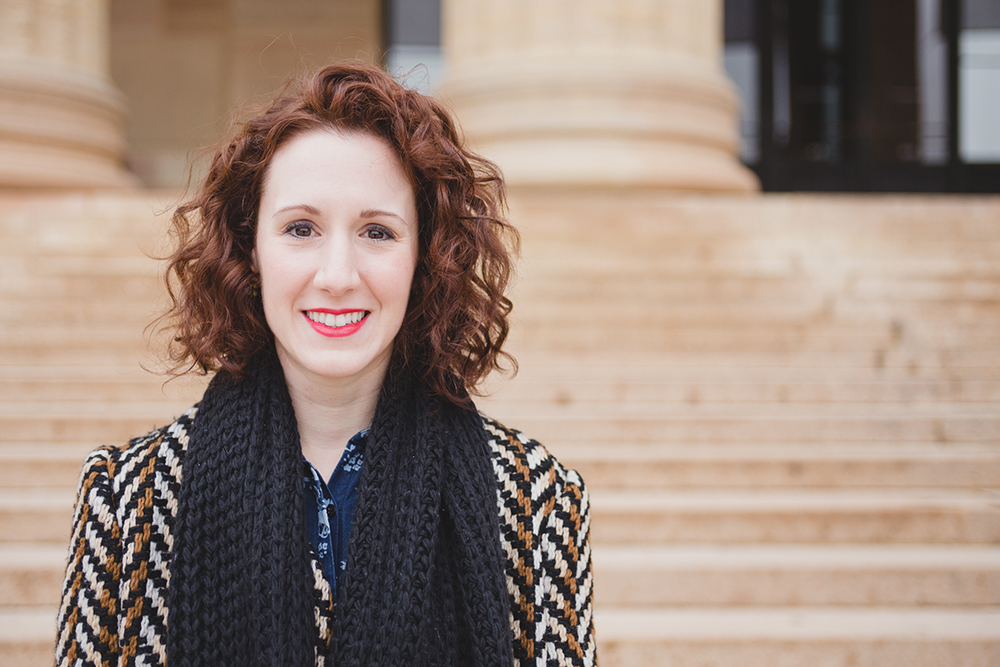
Photo credit: Melissa Alam
Laura Camerlengo is a 2010 alumna of the MA program in the History of Decorative Arts and Design (now the MA program in the History of Design and Curatorial Studies). She is currently organizing a concise exhibition of worldwide embroidery traditions entitled, “Beyond the Surface” for the de Young’s T.B. Walker Textiles Education Gallery. The installation will open in winter 2016. She is also a contributor to the forthcoming publication, “Degas, Impressionism, and the Paris Millinery Trade.” This publication will complement an upcoming exhibition of the same name, jointly organized by the St. Louis Art Museum and the Fine Arts Museums of San Francisco.
Can you tell us a bit about your background and how it led you to studying at Parsons ADHT?
My parents fostered my love of art from a young age with art classes (ranging from painting to ballet) and frequent visits to museums and galleries. But it wasn’t until college that I thought I might enjoy working in the arts. I applied and was accepted to an internship with the Jacques Marchais Museum of Tibetan Art in Staten Island. While there, I became fascinated with their small but rich costume and textiles collection. That internship helped me to realize that I wanted a career that would allow me to work with museum costume and textiles collections, which led me to apply to the History of Decorative Arts and Design MA program.
What was your favorite aspect of the program?
Access to the Cooper Hewitt’s collections allowed us to put our studies into practice – to use critical theories to interpret and understand artworks while still in school.
What do you miss most about New York City?
I have lived in many different parts of the United States, and greatly enjoy immersing myself in the culture of my current city, as I do now in San Francisco. But I am a native New Yorker, so I miss my family and friends most, followed by New York bagels and pizza.
Advice for students entering the MA History of Design and Curatorial Studies program? Students leaving the program?
As we know, today’s job market is extremely competitive. For students who may wish to work in museums, and particularly in a curatorial capacity, I advise focusing their studies and internships as much as possible. Ample educational and professional experience in your intended area of curatorial practice will distinguish you when you apply for your first position – and every position thereafter.
What surprised you most about the program?
My classmates were always happy to share notes, lend a book (or two or more!), and offer leads on opportunities. Solidarity made the program especially rewarding.
How do world events affect your decisions as a curator?
The global landscape is one of many factors that influence curatorial work. We certainly want our exhibitions to be timely and current, but we also have a responsibility to showcase the strengths of our institutional collections, and service the needs and interests of our local constituencies.
Who and/or what inspires you as a curator?
My greatest source of inspiration is the Fine Arts Museums of San Francisco’s costume and textiles collection, which houses more than 13,000 textiles and costumes from traditions around the world. The collection’s strengths range from exquisite ecclesiastical textiles and contemporary Bay Area fiber art to outstanding twentieth-century French couture, particularly the work of Christian Dior, Cristóbal Balenciaga, Madame Grés, and Yves Saint Laurent.
What can you tell us about your upcoming exhibits and publication?
We have a very dynamic exhibitions program at the Fine Arts Museums of San Francisco. Among other projects, I am a contributor to an upcoming exhibition organized by the Museums in collaboration with the St. Louis Art Museum, entitled Degas, Impressionism, and the Paris Millinery Trade. The exhibition is the first to examine the height of the millinery trade in Paris, from around 1875 to 1914, as reflected in the work of Impressionist artists and extant period headwear. In addition, I am currently organizing a concise exhibition of worldwide embroidery techniques from the Museums’ collections for our T.B. Walker Family Education Gallery. Beyond the Surface will feature more than a dozen embroidered costumes and accessories from cultures around the world to explore their distinguished craftsmanship and underlying social and cultural connotations.
Favorite exhibit in 2016?
I am greatly looking forward to seeing Beauty—Cooper Hewitt Design Triennial at the nearby San Jose Museum of Art this fall.
Reading any (related) critical theory?
My current readings center upon fashion and gender identity, on which I will be presenting a lecture for a design history class taught by fellow New School alumna Alessandra Wood (’09) at the University of San Francisco. Among other texts, I am currently reading Linda M. Scott’s Fresh Lipstick: Redressing Fashion and Feminism (2006).


























